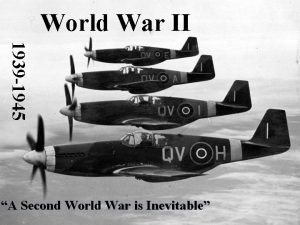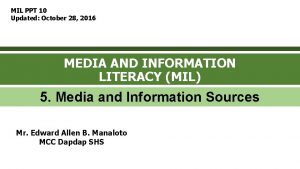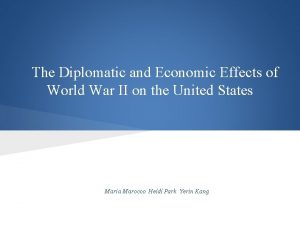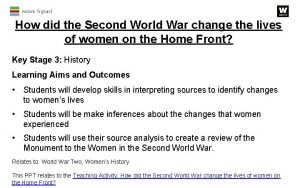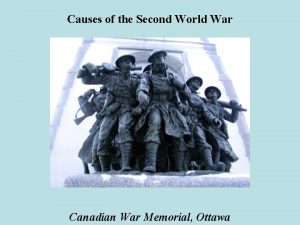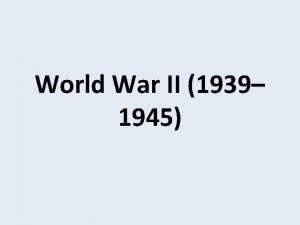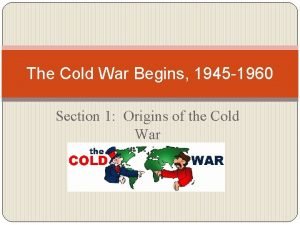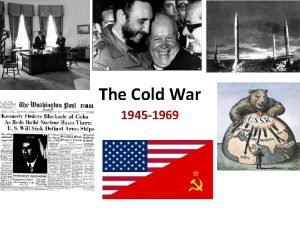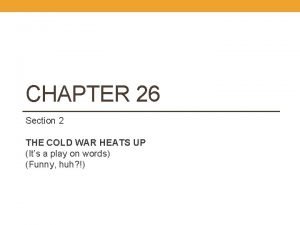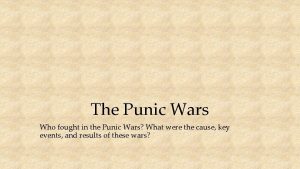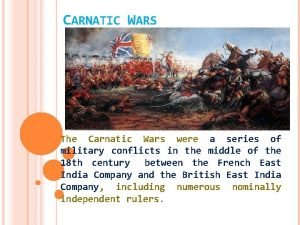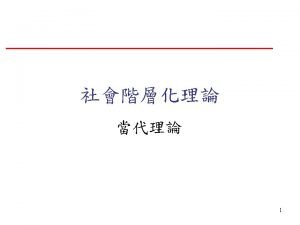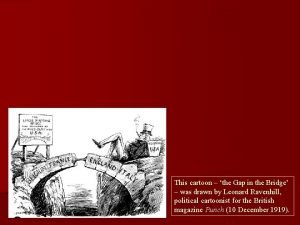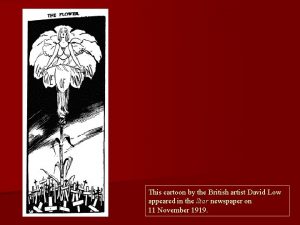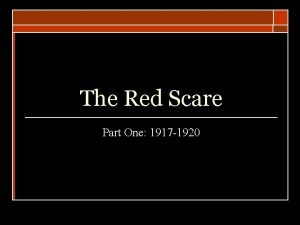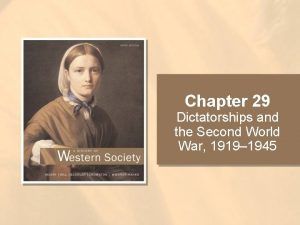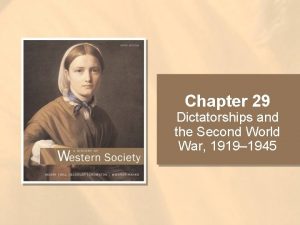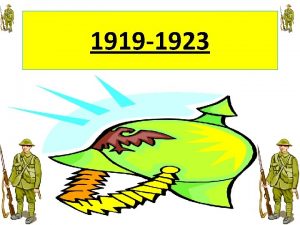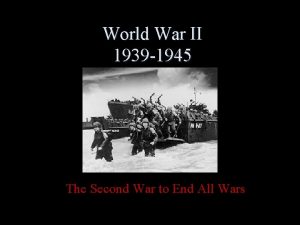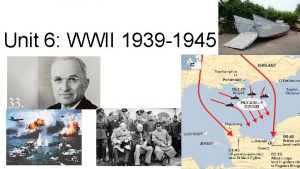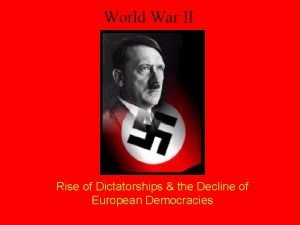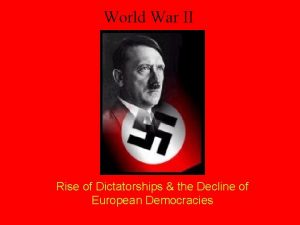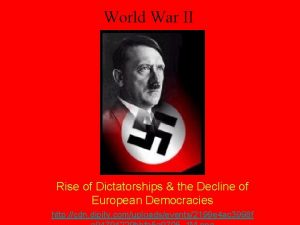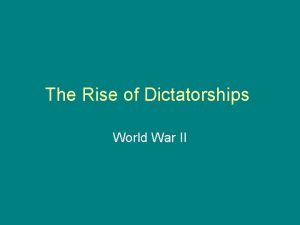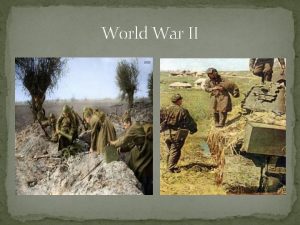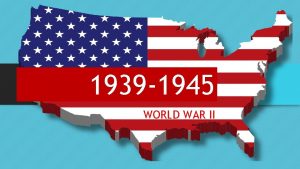Dictatorships and the Second World War 1919 1945





















- Slides: 21

Dictatorships and the Second World War, 1919– 1945 28

I. Authoritarian States A. Conservative Authoritarianism and Radical Totalitarian Dictatorships 1. Conservative Authoritarianism 2. Fascist Governments 3. Totalitarianism 4. Characteristics of Communist and Fascist Dictatorships B. Communism and Fascism 1. Societal Visions 2. Race and Eugenics 3. Mutual Enmity



II. Stalin's Soviet Union A. From Lenin to Stalin (1879– 1953) 1. The New Economy Policy (NEP) 2. Lenin’s Succession 3. Stalin’s Triumph B. The Five-Year Plans 1. The First Five-Year Plan 2. Collectivization and the Kulaks 3. The Cost of Collectivization 4. Industrialization

II. Stalin's Soviet Union C. Life and Culture in Soviet Society 1. Daily Life 2. Personal Advancement 3. Women’s Roles 4. Politicized Culture D. Stalinist Terror and the Great Purges 1. The Kirov Murder 2. The Great Purges 3. The Purges’ Mysterious Origins

III. Mussolini and Fascism in Italy A. The Seizure of Power 1. The Weaknesses of Liberal Italy 2. The Postwar Crisis 3. Benito Mussolini (1883– 1945) 4. The Seizure of Power

III. Mussolini and Fascism in Italy B. The Regime in Action 1. Seeming Moderation 2. The Matteotti Murder and its Aftermath 3. Popular Support 4. The Lateran Agreement (1929) 5. Characteristics of Fascist Italy

IV. Hitler and Nazism in Germany A. The Roots of National Socialism 1. The Origins of Hitler’s Worldview (1889– 1945) 2. The Impact of WWI 3. The Nazi Party 4. The Beer Hall Putsch B. Hitler's Road to Power 1. Mein Kampf (My Struggle) 2. The Rise of National Socialism 3. The Nazi Seizure of Power

IV. Hitler and Nazism in Germany C. State and Society in Nazi Germany 1. Consolidating Power 2. “Coordination” 3. The SA Purge 4. The Racial State 5. The Nuremberg Laws (1935) 6. Kristallnacht (November 9, 1938)

IV. Hitler and Nazism in Germany D. Popular Support for National Socialism 1. Economic Recovery 2. The Volksgemeinschaft (People’s Community) 3. Gender 4. Opponents

IV. Hitler and Nazism in Germany E. Aggression and Appeasement 1. Aggressive Actions 2. Appeasement 3. The Munich Conference 4. The Hitler-Stalin Pact


V. The Second World War A. German Victories in Europe 1. 1939 2. 1940 3. 1941 B. Europe Under Nazi Occupation 1. The New Order 2. Occupation Policies 3. The War of Annihilation 4. Belarus 5. Resistance


V. The Second World War C. The Holocaust (the Murder of 6 Million Jews) 1. Euthanasia 2. Ghettos and Death Squads 3. The Final Solution 4. Perpetrators and Motivations


V. The Second World War D. Japanese Empire and the War in the Pacific 1. Racial-Imperial Ambitions 2. The Greater East Asia Co-Prosperity Sphere 3. The Japanese Offensives

V. The Second World War E. The "Hinge of Fate" 1. The Grand Alliance 2. The Russian Contribution 3. Allied Victories


V. The Second World War F. Allied Victory 1. Increased German War Production 2. The Anglo-American Invasion 3. The Soviet Invasion 4. The War in the Pacific
 1945 world war ii
1945 world war ii 1945 world war
1945 world war School uniform of sshs prior to the second world war
School uniform of sshs prior to the second world war Effects of second world war
Effects of second world war Second world war
Second world war Second world war
Second world war Korban jiwa perang dunia 2
Korban jiwa perang dunia 2 The cold war begins 1945-1960
The cold war begins 1945-1960 The cold war heats up: 1945 - 1969
The cold war heats up: 1945 - 1969 The cold war heats up: 1945 - 1969
The cold war heats up: 1945 - 1969 Who fought in punic wars
Who fought in punic wars 27 miles per gallon into kilometers per liter
27 miles per gallon into kilometers per liter Toward civil war lesson 3 secession and war
Toward civil war lesson 3 secession and war Why were the carnatic wars fought
Why were the carnatic wars fought Davis and moore 1945
Davis and moore 1945 Stbl. 1917 no. 130 jo. 1919 no. 81
Stbl. 1917 no. 130 jo. 1919 no. 81 The gap in the bridge political cartoon point of view
The gap in the bridge political cartoon point of view Cartoon by david low 1933
Cartoon by david low 1933 The red scare of 1919-1920 was provoked by
The red scare of 1919-1920 was provoked by Bourbon triumvirate definition
Bourbon triumvirate definition Das undbild (1919) by kurt schwitters
Das undbild (1919) by kurt schwitters Yıl 1919 şiiri
Yıl 1919 şiiri
